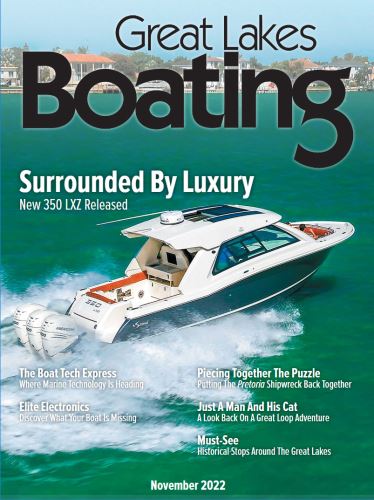
There’s no better time to tangle with a Great Lakes lake trout than early summer. That’s especially true if you’re a fair weather fisherman or have guests aboard who have a tough time stomaching the sea conditions that Inland Seas boaters can face later in the summer. High pressure and low pressure fronts begin fighting for position come mid-summer, and can create some uncomfortable water conditions, even more-so out over the open, deeper waters the lakers prefer once summer heats up. Until then, anglers can locate the prime water temperatures the trout prefer closer to shore, in shallower areas that may not require a long boat ride out to the best fishing grounds and back.
And temperature is key, according to a charter captain with nearly four decades of experience chasing Great Lakes lake trout aboard a 31 Tiara, Far Fetched. Captain Scott Anderson fishes out of one of the most picturesque ports on the Great Lakes, Leland, Mich., where most anglers’ eyes in June and July focus on lakers.
Lake trout are native to Lake Michigan, and there are naturally occurring populations in all five Great Lakes. Deep, cool water is the key to thriving laker populations, and just about every port on the Great Lakes that is near deep water hosts a lake trout fishery. Where abundant, such as lakes Michigan and Superior, lakers served as a primary sport and commercial fish until late last century, when the populations were decimated by sea lampreys that made their way into the system with the opening of the St. Lawrence Seaway.
Thanks to aggressive lamprey control efforts, the trout are undergoing a major resurgence across much of their Great Lakes range – including the waters of their namesake lake off northwest Michigan. Aggressive lake trout stocking efforts are underway across the Great Lakes as well, a program that actually began as a way to control booming alewife populations. At present, with alewife numbers low, according to Stewart, some states are reducing the numbers of lakers and salmon they are releasing to allow the predator/prey ratio to balance out.
The efforts have been successful enough, at least in Lake Michigan, that “the lake trout fishing has been very, very strong the past seven to 10 years,” according to the Leland-based charter captain. “These days, we may start out fishing for salmon for a couple hours, then switch over to target lake trout.”
To locate lakers, Anderson seeks waters in the 48-52 degree range. He’s dropped his downrigger cannonballs as deep as 175 feet to find mid-summer lakers. Early and late in the season, he will still head for deep water, but may not have to drop baits down more than 40 feet to find the preferred temperatures and the trout that hold there. Then again, Anderson may find the target range 30 feet down over water as shallow at 40. Come July and August, he simply follows the cool water as it plunges ever deeper, taking the cold-blooded trout along with it.
As such, summer lake trout fishing is primarily a downrigger sport, requiring the precise depth control the gear offers. However, early in the season while the fish remain in the shallows, vertical jigging is a popular method for catching lakers, which may be feeding on baitfish in water as shallow as 7 feet, according to Anderson. Features such as spot-lock on outboards and bow mounted electrics motors that allow boats to remain over a specific area without anchoring have been a boon to that vertical jigging fishery, said Anderson, allowing anglers to hold over a pod of active lake trout without spooking the fish below.
Day in and day out, however, lake trout fishing is a trolling affair, cruising at sub-2 mph speeds using downriggers to get baits down to the fish.
“And if you think you are going too slow,” advises Anderson when trolling for lakers, “slow down.”
The charter captain uses 20-pound test Maxima line on level-wind reels mounted on 7-foot, 6-inch Shakespeare Ugly Stik rods and knots a 30-foot section of fluorocarbon leader of the same test as a leader. Anderson places lures 10 to 15 feet behind his downrigger balls, which run heavy at 10 to 12 pounds to keep the wire angle as low as possible, and places attractors, such as cowbells and flashers, 12-18 inches ahead of each bait. His preferred lake trout lures include, “Peanuts, Spin-n-Glows, and Whirligigs.”
“I’ve had many people tell me they prefer eating lakers over salmon these days,” said Anderson. “The reason being that now lake trout are not as specific as to what they eat, and will eat more gobies than alewife, so they are not nearly as oily and strong tasting. And their flesh is redder, looking – and tasting – a lot more like the salmon.”
Which is bad news for the lakers but an epiphany for anglers like myself who for years referred to the big water trout as “slimers.”
Guide Spotlight
Captain Lee highlights Captain Scott Anderson
Captain Scott Anderson operates his 31-foot Tiara Far-Fetched out of Leland, Mich. The Michigan native has wanted to be a captain since age 9, when his family spent a Thanksgiving vacation in Pompano Beach, Fla., and chartered a fishing boat.
“We caught a sailfish that day and that was it,” said Anderson, now 73. “My dad had an ice cream business in Michigan so we couldn’t take a summer vacation like everyone else and had to wait until Thanksgiving. After that fishing trip I knew what I wanted to do when I grew up!” (231-941-4376 // www.lelandcharterboat.com)

